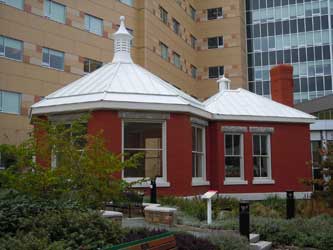The estate of the Hon. Joseph Despard Pemberton, colonial Surveyor General, and his widow Teresa Jane Pemberton both donated funds to build a maternity wing at the hospital. However, the hospital directors concluded that the funds were not sufficient for that purpose, and this octagonal, red brick operating theatre was built instead.
The cornerstone was laid May 15, 1896; John Teague placed a copper box under the stone and Thomas Catterall plumbed the stone. Large windows dominate every wall to admit the maximum amount of daylight. An ornate metal lantern caps the building, and there is evidence of an original entry porch. The floor plan allowed for efficiency, with the patient placed in the centre of the room. The unusual building is dramatically different from the mainstream work of this prolific architect, who is best known for his large, Italianate public buildings (City Hall, Masonic Temple). The operating theatre continued in daily use until 1925, when the East Wing of the Hospital opened.
A school of nursing opened in 1891 but that left the hospital with a $15,000 debt. As well, a smallpox outbreak in 1892 meant that an isolation unit was more urgently needed than an operating theatre. The financial situation was eased by a $2,000 bequest from the Pemberton estate. Dr John Helmcken (638 Elliot St, James Bay) wanted it used for a maternity unit. However, the Pemberton bequest was not adequate for this purpose, even after Sophie Pemberton offered another $1,500 and told the hospital that the donation could be used for anything of benefit to the hospital.
Helmcken’s plan was opposed by Dr John Chapman Davie (638 Rockland Pl), who had come under the influence of the great Dr Joseph Lister, who promoted sterile surgery, while on a European sabbatical leave. Dr Davie wanted to bring antiseptic principles and practices to the Jubilee and eventually his proposal won out, as it was thought that a dedicated operating suite was essential to a modern hospital. Dr Helmcken promptly resigned from the hospital staff.
Thomas Catterall’s tender came to $3,614 and once again, Mrs Pemberton covered the slight deficit.
Dr Davie asked for an almost free-standing building in order to limit access to anyone but patients, doctors and nurses. Dr Lister came to Victoria in 1897 and was impressed with the new operating room, although he recommended adding a recovery room. Two post-op recovery rooms were quickly built and the complex was wired for electricity.
An X-ray machine was installed in 1899, only four years after this new technology became available. It was used until the East Wing of the hospital opened, with up-to-date facilities. The Pemberton Memorial Operating Theatre then became a cancer clinic and was later used to store medical records.
In 1982 the Victoria Medical Society requested heritage protection for the operating theatre, along with the Pemberton Memorial Chapel, as a major expansion of the hospital was planned. Designation was stalled by concerns about the cost of moving these two structures to make space for new buildings. Financial restraints in the later 1980s allowed a reprieve and a further heritage protection request from the Victoria Medical Society, in 1991, described the operating theatre as “the first surgical operating room on the west coast of North America, north of San Francisco.” Heritage designation was granted in 1994 and, by this time, the planners of the hospital expansion had decided that it would cost less to build the expansion around the chapel and the operating theatre, rather than move them (see below re: chapel).
The Victoria Medical Society is raising funds to restore the operating theatre and to create a public medical museum with archives, a library and meeting space. Total cost of the project is estimated at approximately $450,000.
When completed, the Pemberton will be the only restored operating theatre in Canada.


Recent Comments